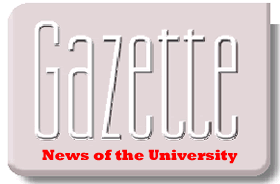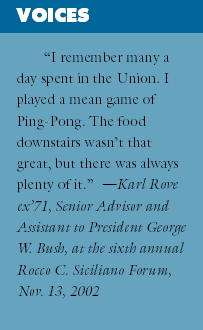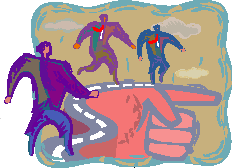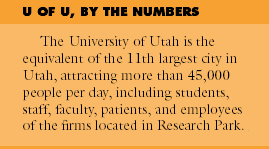
| Vol. 12. No. 4 |
Spring 2003 |
|
The retired couple has taken a jigsaw puzzle hobby and literally turned it into a work of art. Working with boxes and boxes—and boxes—of potsherds stored at the museum, the official repository for state artifacts, the two painstakingly piece together original pottery from the Anasazi and other ancient peoples. “We had worked jigsaw puzzles before,” says David. “Susan is quite good, and they got so easy that she’d turn them upside down for a challenge.” The couple, who volunteer about once a week at the museum, certainly has a challenge now. There are no pictures on boxes of what the finished pottery should look like, no pre-set limit on the number of pieces in a single puzzle, not even information about whether the pieces belong to the same puzzle. “The museum staff vacuums all the catalogued pieces and puts them into archival boxes,” says Wendi King, lab assistant at the museum. “Then,” says David, “we divide the pieces as you would a jigsaw puzzle— by color, by the shape of the rim, etc.” The sorting itself can be a challenge. “We thought the black-and-white pottery would be the easiest, but it wasn’t. We sorted by pattern, but there are none that are wholly complete,” he says. When all or most of a pot can be pieced together, “we start from the bottom, and tape it together to make sure everything fits,” David says. “Then we glue a little bit at a time [using archival glue, which can be reversed]—not too much, or the weight becomes too heavy. For the gluing, we have to work together”—a process they have perfected with practice. The pot is then allowed to set for two or three days. The museum staff marvels at the dedication of the Jabusches, who not only make available pottery vessels that the public wouldn’t otherwise see but also help professional researchers. “When we put even two pieces together, we think we’re helping a scientist learn more about the place and the people,” says David. The couple has been volunteering at the museum for more than 10 ears (“What else are we going to do—stay home and do jigsaw puzzles?” says David), so their acquired knowledge rivals the staff’s. “None of us has the training that these two have,” says King. “They’re knowledgeable and they volunteer their time”—along with more than 250 other museum volunteers. Both David, a retired U of U communication professor, and Susan,
a retired fourth-grade teacher, volunteer extensively throughout
the community. “But my next project,” says David, gesturing
at a table filled with potsherds, “is to write a fictional
story about what’s behind all this”—no doubt in
the form of a mystery to be pieced together. Though business principles and practices are taught every day at the Eccles School of Business, it can be more difficult to teach entrepreneurship. How involved in always-changing, real-world business practices in the classroom? One way is to make the classroom itself an independent, nonprofit entity. The University Venture Fund, a campus- community partnership, is a fully operational 501(c)3 that partners with other venture capital firms in order to invest—eventually—in selected companies. University students, operating out of an office on Main Street, perform the research and learn the procedures for investment. The fund started in the summer of 2001 after Geoff Woolley MBA’83 of Dominion Ventures suggested to Jack Brittain, dean of the business school, that the school might start such a fund. “In the first term, we really worked with students to create the legal entity,” says Leonard Black BS’66 MBA’67, director of the school’s Utah Entrepreneur Center, of which the venture fund is just one of six separate initiatives. “Last spring [2002], we started looking at deal flow. Over the spring and summer, we looked pretty seriously at about 40 deals. We’ve partnered with most of the local firms and perform due diligence [investigating the details of a potential investment] for them.”
Jared Hutchings BS’02, a former student member and now managing director of the fund, points out that while the fund’s next step is to raise money that can be invested (helped by a recent $500,000 donation by entrepreneur James Sorenson ex’48), “the purpose of the fund is not to groom venture capitalists. It’s really to teach students about business, so that they can learn about entrepreneurship and build professional relationships.” In addition to performing due diligence for both local and national firms and meeting with professional mentors, a group of five students recently traveled to New York (with tickets donated by Jet Blue) to meet with the partners for whom they had just completed due diligence. “It’s an amazing opportunity for the students who are selected,” Hutchings says. “I can’t tell you how many times I’ve heard people in the investment community say, ‘I wish they had had something like this when I was in school.’”
|
IN MEMORIAM Charles Dibble, 93, BA’36, Distinguished Professor of Anthropology and a recipient of the University’s distinguished Research, Teaching, and Alumnus Awards. His translation, with Arthur Anderson, of The Florentine Codex revolutionized Mesoamerican studies (see Continuum, Fall 2000). |
 PIECING
IT TOGETHER
PIECING
IT TOGETHER Ever
wondered how some of the amazing pottery at the Utah Museum of Natural
History makes its way to a display shelf? Pieces that may be 900
years old aren’t always sitting intact in a protective site
in, say, southern Utah, waiting for discovery and display. Rather,
archaeologists and others involved in fieldwork often find only
broken pieces and remnants of pottery, some of which, carted back
to the museum, await the patience and skill of two extraordinary
museum volunteers, David and Susan BS’65 Jabusch.
Ever
wondered how some of the amazing pottery at the Utah Museum of Natural
History makes its way to a display shelf? Pieces that may be 900
years old aren’t always sitting intact in a protective site
in, say, southern Utah, waiting for discovery and display. Rather,
archaeologists and others involved in fieldwork often find only
broken pieces and remnants of pottery, some of which, carted back
to the museum, await the patience and skill of two extraordinary
museum volunteers, David and Susan BS’65 Jabusch.  VENTURE
ADVENTURES
VENTURE
ADVENTURES  Students
must apply for the two-semester course (one and a half credits per
semester), and those accepted are expected to put in 15-20 hours
a week at the fund, according to Black. The students meet for two
to three hours every Friday, with guest lectures from members of
the business, legal, insurance, and venture communities. “The
students are broken out into five groups of five, and each group
does due diligence for a venture capital firm that approaches us
with a specific project,” says Black. Members of the local
community also serve as mentors —“people like Scott
McKinley, Bob O’Conner, and Craig Ballard BA’92,”
Black says.
Students
must apply for the two-semester course (one and a half credits per
semester), and those accepted are expected to put in 15-20 hours
a week at the fund, according to Black. The students meet for two
to three hours every Friday, with guest lectures from members of
the business, legal, insurance, and venture communities. “The
students are broken out into five groups of five, and each group
does due diligence for a venture capital firm that approaches us
with a specific project,” says Black. Members of the local
community also serve as mentors —“people like Scott
McKinley, Bob O’Conner, and Craig Ballard BA’92,”
Black says.  Black
agrees. “I don’t think there are any other programs
like ours around the country, with an entity that stands as independently
as ours does,” he says. “We have our own board of directors,
we’re a separate nonprofit, and we raise our own money—but
always with education as our first goal. The experience the students
get is phenomenal—some have started their own businesses,
some have gone to graduate school, some are working for major venture
firms.” So far, like the best educational ventures, those
returns have justified any risks.
Black
agrees. “I don’t think there are any other programs
like ours around the country, with an entity that stands as independently
as ours does,” he says. “We have our own board of directors,
we’re a separate nonprofit, and we raise our own money—but
always with education as our first goal. The experience the students
get is phenomenal—some have started their own businesses,
some have gone to graduate school, some are working for major venture
firms.” So far, like the best educational ventures, those
returns have justified any risks.